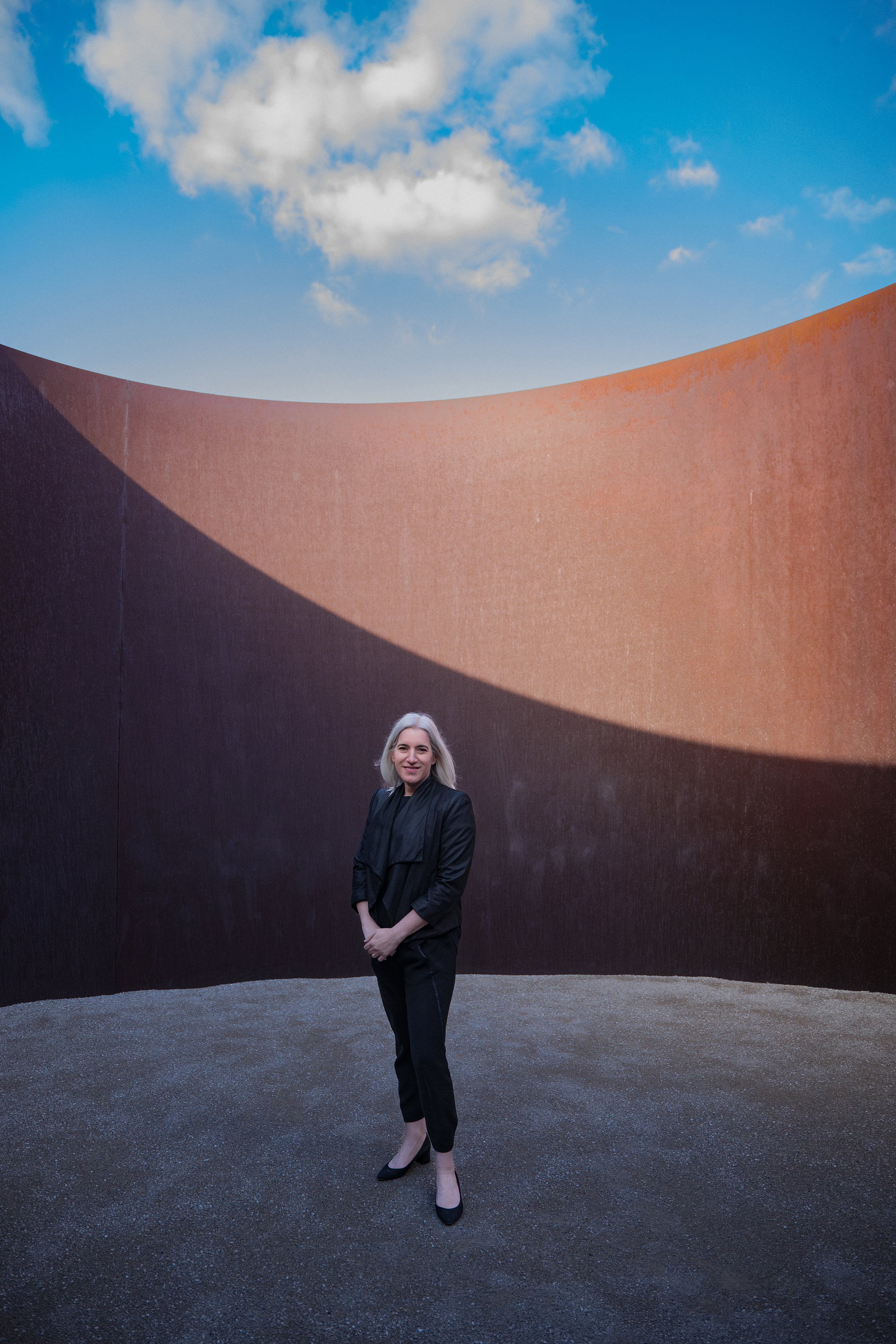The Gift of Art
The Executive Director of the Pulitzer Marks a Decade in the Job.
by Alexa Beattie / Portraits by John Lore; Photos of the Pulitzer by Alise O’Brien
You know Cara Starke’s the right one for the job; she blends right in. After 10 years as the Pulitzer Arts Foundation’s executive director, she and it have begun to blur. Her beautiful hair has turned the exact same color as the Pulitzer’s dove-gray walls and her affect is as peaceful as the stunning modernist space she moves through.
Starke came to the Pulitzer in 2015 from Creative Time, a nonprofit arts organization in New York, considered to be the one of the most visionary and preeminent public art organizations in the county. Before that she served as assistant curator at The Museum of Modern Art in New York. She has a master’s degree in art history from Williams College and a bachelor’s degree from Cornell University. She grew up in Maryland, on the outskirts of Washington D.C. The Red Line was a lifeline, she said, shunting her at high speed to the museums and galleries of the nation’s capital on an extremely regular basis. “I saw things in those places that blew my mind,” Starke says.
The Pulitzer building blows the mind as well. You’ve never seen sunlight so large; never remarked – as you happen to on a drizzly Tuesday morning – how raindrops falling on water sort of look like music. In this place, that reflecting pool is a piece of art as well – galvanizing, never the same and indeed, changing with the weather. “Your body physically responds,” Starke says.
The Pulitzer was founded in 2001 by arts patron and philanthropist, Emily Rauh Pulitzer, who commissioned Japanese architect Tadao Ando to design the building. At the time, it was Ando’s first free-standing public commission in the U.S. (there are still only a handful; among them the Museum of Modern Art Fort Worth and Wrightwood 659 in Chicago). The one on our doorstep may be one of the most sublime spaces you’ve ever stepped foot in.
“In this cultural moment, it’s essential that we provide for joyfulness,” Starke says. “To [help people] see the world through different sets of eyes and imagine a better future.”
This kind of generosity is Starke’s hallmark. She is committed absolutely to sharing the wealth-- bringing wonderful art to as many people as she can. That essentially generous habit of mind may have been most evident during the pandemic when Starke felt it was important to keep the Pulitzer’s doors open to small groups in 45-minute blocks. She says that as far as she knows, the Pulitzer was the only arts organization in the country to have done so.
“It was a gift. And a gift for my staff. Everyone was so isolated.”
That same spirit – of erring always toward beauty – means that Starke has a tendency to “color outside the lines.” In other words, she’s been involved in reclaiming little parcels of urban space and seeding them with native grasses and flowers. A grassy, Pulitzer-owned lot across the street is now known as Park-Like – a one-acre rain garden of more than 100 varieties of native plants. And, a tumbledown, former Baptist church destroyed by fire, has risen again in a whole different way around the corner. The Pulitzer bought this property in 2020, stabilized it and opened it to the public in 2022. The roof opens to the sky; there’s no door or floor or windows. But there’s a magical, unexpected beauty to the flowers and moss and to the blood-red vine that creeps up and over the stones.
“There is so much vacant land in St. Louis,” Starke says. “We are currently asking ourselves what it means to be a landowner in the city, and what does it mean to design for the ecological health of a neighborhood?”
Starke – dressed all in black – moves fluidly through this breathtaking space, talking with reverence about the art it contains. The Pulitzer is not a collecting museum but, rather, a temporary host for historic and contemporary artworks from around the world. There are a few permanent pieces requested by Emily Pulitzer to specifically complement the architecture. A two-tone wall sculpture by Ellsworth Kelly called “Blue Black” presides over the Main Gallery and a massive torqued steel spiral called “Joe” in the outdoor courtyard was made by Richard Serra in honor of Emily Pulitzer’s husband, Joseph Pulitzer, who died in 1993.
As a cultural and civic asset, the Pulitzer Foundation is also a space for other art forms, providing an array of free readings and lectures, dance, wellness workshops and musical performances.
Although Starke took a few life-drawing classes in high school, she said she has never thought of herself as an artist. But considering her resume, her finely-tuned sensibility to beautiful things, artistry, we wager, runs in her blood.
The current exhibit, Scott Burton: Shape Shift, runs through February 2.
PBS Channel 9 “Living St. Louis” producer Patrick Murphy tours the Pulitzer Foundation for the Arts in Grand Center in 2009.





